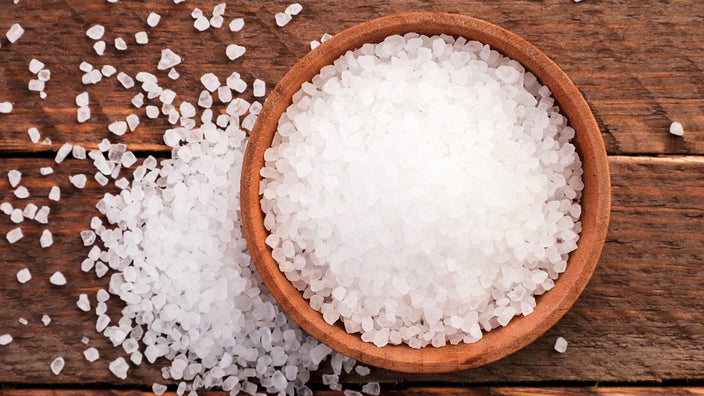
What Is A High Sodium Level?
Key takeaways:
A high sodium level in the blood (hypernatremia) often means there is not enough water in the body rather than too much salt.
A high sodium level can happen when you are dehydrated and not drinking enough water. But there are other medical conditions that can affect your sodium level as well.
In most cases, the symptoms of hypernatremia are mild and easily treated. But severely high sodium can lead to serious complications, like seizure or coma.

Sodium is an electrolyte that is in your blood and the fluid that surrounds cells. Your sodium level is a measure of how much salt and water is in your body.
Hypernatremia is a medical condition in which the sodium level is too high. This usually comes from dehydration, when there is not enough water in the body to properly dilute the sodium. It’s also possible to develop hypernatremia if too much salt enters the body, but this is less common.
Read on to find out the different causes of hypernatremia, how it is treated, and the potential complications.
Save every month on GLP-1 meds with GoodRx
Save an average of $235 on FDA-approved GLP-1s like Ozempic and Zepbound.

What causes a high sodium level (hypernatremia)?
A high sodium level is usually caused by dehydration, so conditions that make the body lose water are often involved. This can happen in a lot of different ways if people aren’t drinking enough fluids to replace that water they are losing. Some examples are:
Sweating, such as from excessive heat, exercise, or even a fever.
Gastrointestinal losses, like vomiting or diarrhea.
Excessive urination, from things like diuretic medications or increased blood sugar levels in people with diabetes.
On rare occasions, people get a high sodium level if too much salt enters the body. It’s hard to do this simply through dietary intake and eating salt foods. When this happens, it’s usually from people getting IV fluids, which can have a lot of sodium in them. But this is still uncommon, especially because people who are getting a lot of IV fluids are usually having their sodium level checked frequently.
Who’s most at risk of a high sodium level?
The body has built-in mechanisms to naturally prevent hypernatremia. When a sodium level starts to rise, the brain triggers the sensation of thirst. Most people will simply find something to drink, which rehydrates the body before a high sodium level becomes a problem.
There are some situations where that thirst mechanism is broken or someone isn’t able to drink water when they need it. Some examples of this include:
People in excessive heat who don’t have access to liquids.
People who rely on a caretaker to help keep them hydrated, such as children, older adults, or people with disabilities.
Situations where it is difficult for someone to keep up with their fluid losses, such as someone with diabetes or gastroenteritis (the stomach flu).
Some people might also be in a mental state where they do not experience the drive to drink fluids, such as in older adults or people who have a condition that is making them confused or lethargic.
Read more like this
Explore these related articles, suggested for readers like you.
What are the symptoms of a high sodium level?
The symptoms and severity of a high sodium level depends on both the actual level and how fast the sodium level is rising. The body doesn’t like fast changes in the sodium level. If the level changes slowly, the body has time to adjust. And, so, rapid climbs in the sodium level are more likely to cause more noticeable and serious symptoms.
A normal sodium level is 135 to 145 mEq/L. Slight increases above this range, or slow rises in the sodium level, may cause mild symptoms such as:
Thirst
Muscle weakness
Restlessness
Nausea or vomiting
Poor appetite
A sodium level above 160 mEq/L is serious and can lead to more severe symptoms. But this can also happen if the sodium level rapidly changes, even changing from from 135 to 150 mEq/L. These symptoms include:
Confusion
Lethargy
Seizures
How do you diagnose a sodium imbalance?
Sodium level is tested with a blood test. While there may be signs of a high sodium level such as the symptoms we talked about above, the only way to truly test a sodium level is by a blood draw.
How do you treat a high sodium level?
The treatment for a high sodium level is rehydration. In mild cases, this might just mean drinking some extra water. In more severe cases, people may need special fluid through an IV in the hospital.
Just like the body doesn’t like the sodium level to rise too quickly, it also doesn’t like it to drop (or normalize) too quickly. This is especially true if the sodium level has been high for a long time. This means that people usually rehydrate slowly. In severe cases, healthcare providers will check blood work frequently to make sure the sodium level isn’t dropping too quickly.
Given it is important to fix a high sodium level in a safe way, it is always best to do this with the guidance of your healthcare provider.
The bottom line
A high sodium level isn’t a common condition. Most people will naturally want to drink more water when the sodium level starts rising. Your body does a great job of keeping your sodium level in check this way, without you even knowing it. If you aren’t able to drink fluids when you need them, or your thirst mechanism is altered, you are at a higher risk of this condition. In serious cases, you might need to be admitted to the hospital for safe treatment.
Why trust our experts?


References
Arampatzis, S., et al. (2012). Characteristics, symptoms, and outcome of severe dysnatremias present on hospital admission. The American Journal of Medicine.
Braun, M. M., et al. (2015). Diagnosis and management of sodium disorders: Hyponatremia and hypernatremia. American Family Physician.
MedlinePlus. (2020). Sodium blood test. National Library of Medicine.





